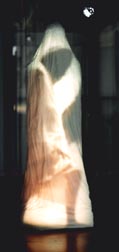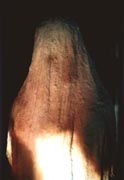Catalog Text:
What was Lot's Wife's Name?
-
- I. A Pillar of Salt
-
- A pillar of salt gives the slightest hint of a female form;
a veiled woman crystallized. She appears not in the black robes
of burqua, silent shadow of a hidden human - rather, she is the
pure white of the angels that rescued her... and doomed her.
She is white and shining like a desert moon.
-
- A spirit seems to move within the pillar, forever looking
back, again and again. She is a fallen angel, the Good Wife who
chose her own will at last. She is the purity of her virgin daughters,
the nurturing mother, the desiccated crone. She is a Medusa,
frozen by her reflection, the faces of the women she left behind.
The real Medusa was no monster. She was a fighting queen.
-
- What was Lot's Wife's Name? is an installation which sets
the calcified myth, a pillar of salt with video projection, in
dialectic standoff with an advocate of righteous violence, a
preacher of the airwaves, a disembodied monitor. Both story and
teller are illuminated objects, animated by light. Both are steadfast
characters, maintaining their positions, repeating and repeating.
He offered his virgin daughters to the mob
"and do ye to them as is good in your eyes"
Sin, salvation, sacrifice -
her name was?
Abraham offered his son
(he did it)
offer your...
HE did it.
The Good Wife
Lot's Wife
The wife
my wife...
-
- II. Taboo
taboo (also tabu): (noun) A prohibition
excluding something from use, approach, or mention because of
its sacred and inviolable nature. 1
-
- In 1984 I encountered the poet Celia Gilbert and her then
unfinished poem, Lot's Wife, for the first time. This
poem, telling the story of Sodom and Gomorrah from the traditionally
untold point of view of the fated wife, weaves the biblical tale
together with archival interviews of the American pilots who
dropped the bombs on Hiroshima and Nagasaki during W.W.II and
the doctors who treated the victims, revealing the strong resemblance
between the mythical and the real events. The combined texts
create a self-evident protest against condoned violence, tracing
the deepest roots of violence and oppression to the story of
Genesis. This poem, in both form and content, made a lasting
impression on me. The 1986 video-sculpture The Golden Calf
and the 1988 photographs Angel Series both take their
influence from Lot's Wife. What was Lot's Wife Name?
is my third adaptation of Gilbert's work.
-
- When asked to contribute to the exhibition Gewalt-Tabu,
"Force-Taboo", to deal with the mistreatment of women
in our time, my thoughts returned immediately to the roots of
abuse in our society, to the origin of our ethics. My thoughts
returned to Lot's Wife.
-
-
- III. Genesis 19:26
The sun was risen upon the earth when Lot entered into
Zoar.
Then the LORD rained upon Sodom and Gomorrah brimstone
and fire from the LORD out of heaven;
And he overthrew those cities, and all the plain, and all the
inhabitants of the cities, and that which grew upon the ground.
But his wife looked back from behind him, and she became a pillar
of salt. 2
-
- Flashback: Lot shows up at home one night with two
strange men - angels, unbeknownst to her. She cooks them dinner.
Her house is attacked by a raping mob, in search of the men.
Code of hospitality dictates protection. Her husband offers up
their two virgin daughters to the mob in an attempt to pacify
the attackers. Good luck: via a miracle, men, daughters, and
Lot are rescued, but, the next morning the strangers force her
and her family to leave their home, empty handed, commanding
them to flee.
- She had married a foreigner, followed him to a strange city,
bore him children, and built up her life in a new land. Little
information about her remains, not even her name. She is remembered
only as the wife of the man Lot, the one who looked back. But
why did she do it?
-
- Lot was informed as to Jehovah's plan of destruction, but
was she? The angels only spoke with him. Perhaps she didn't know
her home was about to become ground zero. Perhaps she knew and
looked back out of pity for her friends, the other women of the
town and their children, annihilated for the sins of their men.
Perhaps she only looked away from her husband, furious at Lot
for offering their daughters to the mob - or perhaps her anger
went much deeper than that. Perhaps her anger was against the
angels and their God for condoning Lot's offer. Perhaps she looked
back in protest against the righteous genocide of Jehovah. Perhaps
she was just fed up. Perhaps. We'll never know.
-
-
- IV. Force
force: (noun) [1.a] Strength, power. [b]
The exertion of such power. [2] A body of persons organized for
a certain purpose, esp. for the use of military power. (verb)
[1] To compel to perform an action. [2] To inflict or impose.
3
-
- Riane Eisler, author of The Chalice and the Blade: Our
History, Our Future, postulates that the dramatic rise in
domestic violence and rape in the United States since the 1970's
is a reactionary response to women's gains in political and social
equality with men during this time. Feeling themselves threatened
at a cultural level, individuals strike back with a form of violence
which symbolically reinstates their "lost" male dominance.
A similar reaction can be seen on a global scale with the increasing
power of fundamentalist religions and their heavy repression
of women. The situation can be viewed as a tug-of-war; the further
women progress their basic rights, power, education, and independence,
the more extreme becomes the subliminal reaction against them.
-
- A recently distributed email
petition protesting the current condition of women in Afghanistan,
written by Kathleen Barbosa, states:
-
Since the Taliban took power in 1996, women have to
wear burqua and have been beaten and stoned in public for not
having the proper attire, even if this means simply not having
the mesh covering in front of the eyes. ... Homes where a woman
is present must have their windows painted so that she can never
be seen by outsiders. They must wear silent shoes so that they
are never heard. Women are not allowed to work or even go out
in public without a male relative...
Husbands have the power of life and death over their
women relatives, especially their wives, but an angry mob has
just as much right to stone or beat a women, often to death.
... One woman... was stoned to death for trying to leave the
country with a man that was not a relative. Those without male
relatives or husbands are starving . ...Women live in fear of
their lives... 4
-
- The current situation in Afghanistan is a most extreme example,
difficult for westerners to understand, but oppressed women can
also be found in Europe and the US - held by force, silenced
by taboo. Their burquas are woven of lies we prefer not
see beyond. I see these women as complements to Lot's Wife: they
- buried alive behind their veils, their humanity forgotten,
impotent; she - name forgotten, her humanity exemplified, entombed
in white salt for exerting her will. The pillar of salt remains
as her testimonial, a woman's eternal stand in protest against
violence.
-
- © Clea T. Waite, 1999
-
-
-
- What was Lot's Wife's Name?
Video-sculpture, 1999. Salt, video projection, and monitor.
Two channels of video.
-
- Conceived and created by Clea T. Waite. Lot's Wife: Yvette
Torell. Angel: Nicola Ferrier. Grateful acknowledgments to Celia
Gilbert, DngerVideo, and Susanne Themlitz for their inspiration
and assistance.
-
-
- Footnotes
- 1 The American Heritage Dictionary. Houghton Mifflin
Co. 1993.
2 Genesis (19:23-26], King James Bible.
3 The American Heritage Dictionary. Houghton Mifflin Co.
1993.
4 Email petition,
circulated by Kathleen Barbosa, 1998
|


